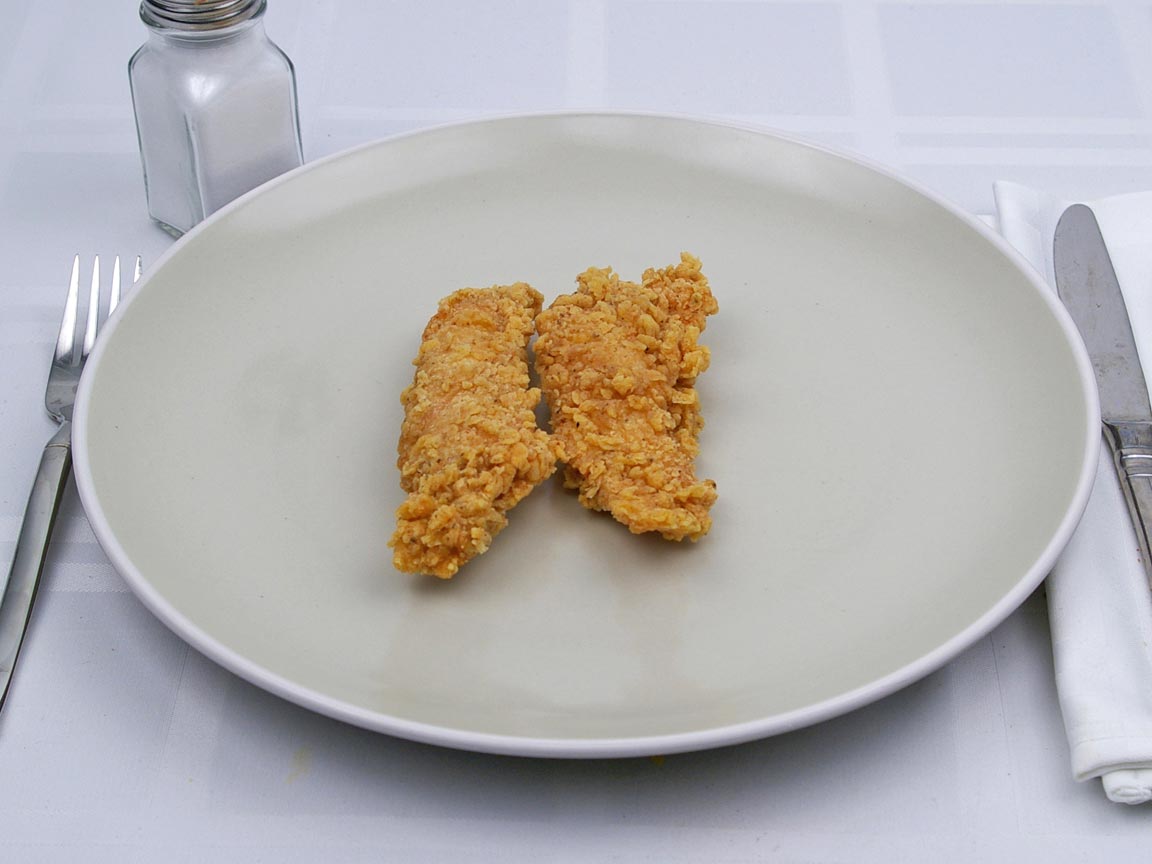Chicken tenders are a popular finger food and appetizer. Both kids and adults like them because they don’t taste too strong and are soft. But because of their crunchy breading and the creamy sauces that are often served with them, chicken tenders get a bad name as an unhealthy fried food.
So how many calories are actually in 2 chicken tenders? The answer is, it depends. The calorie count can range quite a bit based on the size of the tenders and how they are prepared. By understanding the factors that affect the calories in chicken tenders, you can make better choices and balance them into a healthy diet.
Counting Calories in Chicken Tenders
Chicken tenders are typically made from cuts of boneless skinless chicken breasts that are sliced into long thin strips then breaded and fried or baked. A 2-piece serving can range from around 200 calories on the lighter end up to over 500 calories for larger, heavily breaded tenders served at some restaurants.
Here are some of the factors that affect the calorie count
-
Size: Larger tenders naturally contain more calories than smaller, bite-sized tenders. Pieces cut from a whole chicken breast will have the highest calorie count.
-
Breading: Breaded tenders absorb more oil when fried, increasing calories. Thicker breadings like “crispy” versions add even more.
-
Cooking method: Frying packs in more calories from absorbed oil. Grilling, baking, or air frying are lower calorie options.
-
Sauces and seasonings: Heavy sauces like ranch, honey mustard, and BBQ sauce add calories. Lighter dips and herbs/spices are better options.
-
Added ingredients: Ingredients beyond the chicken and breading, like bacon bits, cheese, etc. will raise the calorie count.
Estimating Calorie Counts
The exact number of calories in 2 chicken tenders can vary a lot because different restaurants and brands use different portion sizes and cooking methods. Here are some general estimates based on common preparation styles:
-
Grilled tenders: Around 200-300 calories for 2 average grilled tenders.
-
Baked tenders: Can range from 200-400 calories depending on size and breading.
-
Air fried tenders: Similar to baked, 200-400 calories. The breading has less oil absorption.
-
Fried tenders: Around 300-500 calories for 2 smaller fried tenders. Larger or “crispy” tenders may have 500-600 calories.
-
Fast food tenders: Varies by restaurant from 300-500+ calories for a 2-piece serving. Check nutrition info.
If you don’t have calorie information available, these rough estimates can help guide your choices. Keep portion sizes reasonable, avoid heavy breading and fried options when possible, and use lighter sauces and seasonings.
Tips for Lightening Up Your Tenders
Chicken tenders don’t have to be diet disasters. With some simple substitutions and preparation tricks, you can enjoy tenders as part of a balanced diet:
-
Opt for grilled, baked or air fried instead of deep fried.
-
Try using cornflake crumbs or panko breadcrumbs for a lighter breading.
-
Skip the breading completely for naked tenders.
-
Use Greek yogurt or avocado-based dips instead of creamy, high-fat sauces.
-
Spice it up with herbs, spices, lemon, and hot sauce instead of sugary barbecue sauce.
-
Pair your tenders with a side salad instead of fries for a nutrition boost.
Healthiest Ways to Enjoy Chicken Tenders
While they aren’t the lowest calorie option out there, chicken tenders can be incorporated into a healthy diet when prepared right. Here are some of the healthiest ways to enjoy 2 chicken tenders:
-
Baked or grilled with just a squeeze of fresh lemon juice and spices.
-
Air fried with a light panko breading and drizzled with a spicy honey mustard sauce.
-
Baked then chopped up and served on top of a fresh salad with light balsamic vinaigrette.
-
Simmered in a skillet in tomato sauce or light curry coconut milk sauce for a flavorful tender recipe.
So be mindful about portion sizes, prep methods, and ingredients, and you can satisfy that chicken tender craving guilt-free! Aim for around 200-400 calories as a reasonable range for a 2-tender serving.

Nutrition Facts Serving Size: 1 serving
| Calories | 110.0 | Total Fat | 0.0 g |
|---|---|
| Saturated Fat | 0.0 g |
| Polyunsaturated Fat | 0.0 g |
| Monounsaturated Fat | 0.0 g |
| Cholesterol | 60.0 mg |
| Sodium | 260.0 mg |
| Potassium | 0.0 mg |
| Total Carbohydrate | 0.0 g |
| Dietary Fiber | 0.0 g |
| Sugars | 0.0 g |
| Protein | 22.0 g |
| Vitamin A | 0.0 % |
|---|---|
| Vitamin B-12 | 0.0 % |
| Vitamin B-6 | 0.0 % |
| Vitamin C | 0.0 % |
| Vitamin D | 0.0 % |
| Vitamin E | 0.0 % |
| Calcium | 0.0 % |
| Copper | 0.0 % |
| Folate | 0.0 % |
| Iron | 0.0 % |
| Magnesium | 0.0 % |
| Manganese | 0.0 % |
| Niacin | 0.0 % |
| Pantothenic Acid | 0.0 % |
| Phosphorus | 0.0 % |
| Riboflavin | 0.0 % |
| Selenium | 0.0 % |
| Thiamin | 0.0 % |
| Zinc | 0.0 % |
Nutrition FactsCalories in Boneless Skinless Chicken Tenders (2 Pieces=1 Serv)Serving Size: 1 serving
- Amount Per Serving
- Calories 110.0
- Total Fat 0.0 g
- Saturated Fat 0.0 g
- Polyunsaturated Fat 0.0 g
- Monounsaturated Fat 0.0 g
- Cholesterol 60.0 mg
- Sodium 260.0 mg
- Potassium 0.0 mg
- Total Carbohydrate 0.0 g
- Dietary Fiber 0.0 g
- Sugars 0.0 g
- Protein 22.0 g
*Percent Daily Values are based on a 2,000 calorie diet. Your daily values may be higher or lower depending on your calorie needs.
- Vitamin A 0.0 %
- Vitamin B-12 0.0 %
- Vitamin B-6 0.0 %
- Vitamin C 0.0 %
- Vitamin D 0.0 %
- Vitamin E 0.0 %
- Calcium 0.0 %
- Copper 0.0 %
- Folate 0.0 %
- Iron 0.0 %
- Magnesium 0.0 %
- Manganese 0.0 %
- Niacin 0.0 %
- Pantothenic Acid 0.0 %
- Phosphorus 0.0 %
- Riboflavin 0.0 %
- Selenium 0.0 %
- Thiamin 0.0 %
- Zinc 0.0 %
Chicken Tenders and WEIGHT LOSS in the same sentence???
FAQ
How many calories are in a piece of chicken tenders?
There are 88 calories in 1 piece of Chicken Tenders. Calorie breakdown: 55% fat, 23% carbs, 22% protein. There are 88 calories in 1 piece of Chicken Tenders. Get full nutrition facts and other common serving sizes of Chicken Tenders including 1 oz and 100 g.
Is chicken tenders low in carbohydrates?
This food is low in carbohydrates and sugar relative to the fiber, protein, and fat. It is a good choice for maintaining healthy blood sugar levels. How many calories are in this food? What is it made of? Find out about the calories, protein, carbs, fats, vitamins, minerals, and more in Chicken Tenders.
How many ounces is a chicken tender?
The recommended portion size for chicken tenders is 3-4 ounces, which is roughly equivalent to 2 chicken tenders. 3. How can I reduce the calorie content of chicken tenders? To reduce the calorie content, consider baking or grilling chicken tenders instead of frying them.
How many calories are in a medium size chicken tender?
Medium size chicken tenders (37 g) contain about 100 calories. Take a look at calories and nutrition for one chicken tenders, cup or half cup of chicken tenders. All data you need.
How many calories are in a grilled chicken tender?
A typical 4-ounce serving of grilled chicken tenders contains approximately 120-150 calories, while a standard 3. 5-ounce serving has about 165 calories, mostly from lean protein. This food is good for you because it is low in fat and high in protein. One serving gives you a lot of your daily protein needs.
How many calories are in a 100 g chicken tender?
100g of chicken tenders contain about 271 calories (kcal). To illustrate, a medium size chicken tenders (37 g) contains about 100 calories. These calories make up about 5% of the daily recommended intake for a normal adult of average weight and activity level (based on a 2000 kcal daily intake).
How many calories do 2 chicken tenders have?
Two chicken tenders can range from 220 to 320 calories depending on how they are prepared.
How many calories are in one chicken tender?
How many calories are in 2 pieces of Grilled Chicken Tenders?
One cup of Two grilled chicken tenders is around 250 grams and contains approximately 412 calories, 78 grams of protein, 9 grams of fat, and 0 grams of …
How many calories are in 2 pan seared chicken tenders?
2 serving of pan fried chicken tenderloins contains 92 Calories The macronutrient breakdown is 6% carbs, 55% fat, and 39% protein. This is a good source of protein (16% of your Daily Value) and vitamin b6 (25% of your Daily Value).
